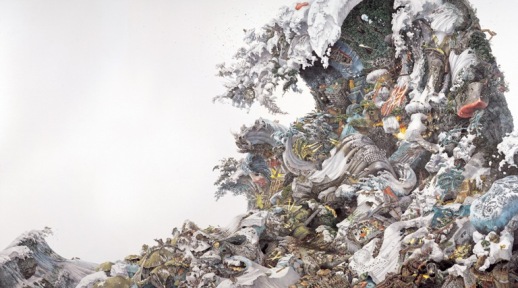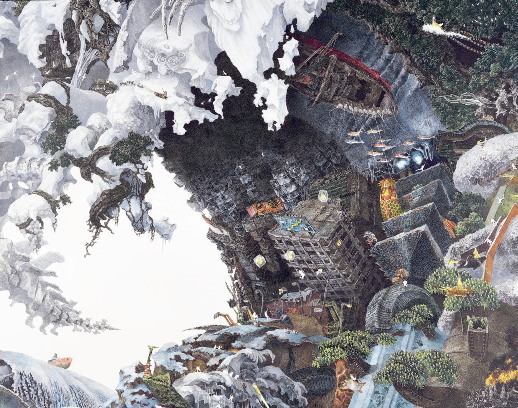Waves of Detail
With only three works — one large, two small — Manabu Ikeda’s untitled exhibition might sound disappointing. But what it lacks in volume it easily makes up in detail, for the main painting is indeed a showcase for the artist’s consummate skill with the minute and his bravado scale.
The central piece ‘Foretoken’ depicts a typical Ikeda vision: a world contained in the shape of a wave. From afar the overall form is very apparent but the closer one gets the less marine it seems – the viewer is engulfed in the detail of the world, and one realizes that in fact there is very little water depicted. This gimmick makes for an interesting experience in the small gallery room, an almost physical change in the viewing process as you makes your way from the door up to the white line marking how close you can peer at the miniature.

I call it a ‘miniature’ (saimitsuga) because that is the genre name bandied around by the gallery and the journalists. However, I am not satisfied with this term, since Ikeda’s work is nothing like the manuscript miniature tradition of the west, and much more an obvious part of the ‘neo-nihonga’ generation of painters revolving around Mizuma Gallery.
The term is probably employed because of the microscopic detail in the work. Indeed, the viewer becomes lost as their eyes explore all the figures and scenes happening in the painting. From the mundane (factories, fishing), to the fun (Shinto shrines, parachutists, koinobori) and the emotive (a foetus in a womb formed out of the very crest of the wave): this is an entire urban world, with a scale something akin to George Cruikshank’s ‘The Worship of Bacchus’ crossed with Where’s Waldo.
The pale colours, achieved by pen and acrylic, recall nihonga and of course ukiyoe (in particular Hokusai). Like Hisashi Tenmyouya and Gaku Azuma, Ikeda is imitating past forms of Japanese painting. But rather than using it as a way of engaging with the present (as, say, Makoto Aida does with his polemic), there is something irritatingly juvenile about his subject matter. One cannot deny the breathtaking detail — but you asks yourself how different is this to manga or the book covers of sci-fi pulp fiction.
Taking a step back (literally) and looking at the painting anew, you are struck by its apocalyptic nature; it is almost biblical, with its fires and accidents, the fractured hulls of ships and planes buried in the wave. And this wave itself, it is in fact a giant towering form, on the verge of crashing down. This is a violent depiction of disaster, collapse. The end of the world. But then look at the other pieces, two smaller works showing monsters and dragons, again attractively and cleverly represented. Aren’t these just posters for teenage boys?

This kind of painting is pop. Along with the other artists who emerged from galleries like Koyama, this is a style of colour and impact. It appropriates past genre and technique, and beguilingly turns it into something queasily contemporary with hints of the past.
Tenmyouya may believe himself to be a rebel in the spirit of historical warrior figures, but I rather think his ‘counter-culture’ is merely a cynical, and successful, attempt to pander to the juvenile tendencies in the Japanese consumer and the naïve delights of the overseas market. Those samurai acrylic paintings arrest you; it is a screen painting but it looks like graffiti – and the samurai has an Uzi. This is seduction, impressing the viewer with its technique and form, and yet offering no substance.
I confess. I too was initially taken in by the visceral charms of Ikeda, Akira Yamaguchi et al. But how I yearn for some sincerity. Instead we have ruthless commercialism. Yayoi Kusama making t-shirts for Uniqlo. Takashi Murakami and his corporation.
For colour and flair, I recommend Manabu Ikeda. For depth, I cannot.
William Andrews
William Andrews



